February 4, 2022
El Paujíl is a site that doesn't receive the same accolades as some of the other trails near Inírida. It generally isn't included in the itinerary of a birder only staying in the region for four or five nights, since the habitats found there can also be visited at other locations. Since Laura and I had well over a week, we decided to spend a morning at the El Paujíl trail since the eBird hotspot had an intriguingly diverse bird species list.
The trail to the El Paujíl community begins on the far side of the Río Inírida and thus, requires a boat to reach it. It is, however, in relatively close proximity to the town of Inírida. An indigenous escort is also mandatory and Mario arranged that for us beforehand. We picked up our escort at dawn and within minutes were at the beginning of the trail.
The first stretch of trail passed through tall, seasonally-flooded forest. Bird-song was evident at that early hour but it took a while to actually see much of consequence. We heard our first Blue-crowned Trogon as an early highlight, while a group of Humboldt's Squirrel Monkeys provided some entertainment in the trees above the path.
 |
| Humboldt's Squirrel Monkeys - El Paujíl, Inírida, Guainía, Colombia |
We reached a small side-trail and followed it towards the edge of an oxbow lake. Here, the semi-open landscape proved to be attractive for birds and we quickly enjoyed great views of numerous species. The haunting call of a Long-billed Woodcreeper caught my attention and soon we were watching this fantastic species as it worked a nearby trunk. We also heard our first Silvered Antbird of the trip, watched a Slate-coloured Hawk, and listened to a Ferruginous Pygmy-Owl tooting away. Heron-types were very much present, such as this immature Rufescent Tiger-Heron.
 |
| Rufescent Tiger-Heron - El Paujíl, Inírida, Guainía, Colombia |
A group of Hoatzins perched on the far side of the lagoon. This bizarre species is the only member of the order Opisthocomiformes, a line that diverged shortly after the dinosaurs went extinct. As you would expect from a bird this unrelated to all other species currently living on earth, it has many peculiarities. For one, Hoatzins have foregut fermentation. That is, they have bacteria in their crops which help break down the leafy material that they ingest, similar to the process utilized by cattle and other bovines. Hoatzins have a proportionally large crop which displaces the flight muscles and the keel of the sternum, severely diminishing their flight capability. The smell caused by the large amount of fermenting leaves in their crops give rise to a popular name for this bird: the stinky turkey.
 |
| Hoatzin - El Paujíl, Inírida, Guainía, Colombia |
Patience and a discerning eye is key to observing wildlife in a tropical rainforest. Laura and I were rewarded with a few cryptic discoveries: a diminutive Green-and-rufous Kingfisher perched quietly in the shadows, a group of roosting Proboscis Bats sat motionless on a snag, and a beautiful Diving Lizard waiting in ambush for its insect prey.
 |
| Green-and-rufous Kingfisher - El Paujíl, Inírida, Guainía, Colombia |
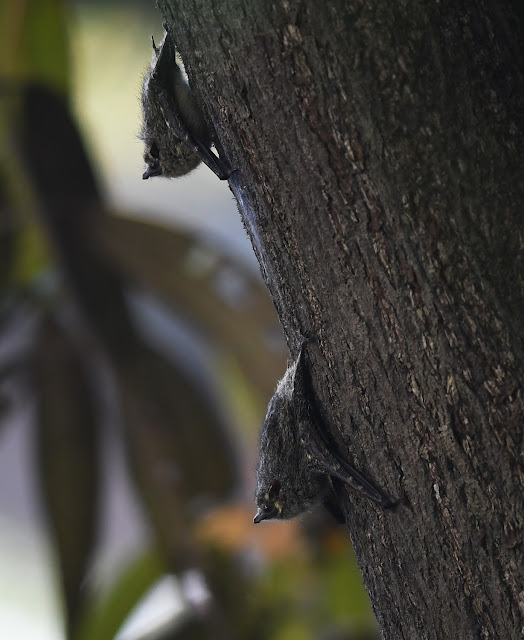 |
| Proboscis Bats - El Paujíl, Inírida, Guainía, Colombia |
 |
| Diving Lizard (Uranoscodon superciliosus) - El Paujíl, Inírida, Guainía, Colombia |
 |
| Varzea Schiffornis - El Paujíl, Inírida, Guainía, Colombia |
A Gray-headed Kite caught our attention as it vocalized frequently from the top of a dead snag above us.
 |
| Gray-headed Kite - El Paujíl, Inírida, Guainía, Colombia |
We left the lagoon area behind and the landscape quickly transitioned from mature, shady igapó forest to stunted, open white-sand forest. The bird composition completely changed and we began seeing many of the specialties of this unique habitat: Spotted Puffbird, Brown and Paradise Jacamars, Helmeted Pygmy-Tyrant, Swainson's Flycatcher, and more.
 |
| Spotted Puffbird - El Paujíl, Inírida, Guainía, Colombia |
We even found a pair of Pectoral Sparrows which is a species that has only been recorded in Inírida on a couple of previous occasions. Clearly, they are around but there is so much more to learn about the avifauna of this region.
 |
| Pectoral Sparrow - El Paujíl, Inírida, Guainía, Colombia |
During our time in Inírida, whenever Laura and I were birding at the edges of clearings I kept an eye out for flowering trees that may be attractive for hummingbirds. Several species of small hummingbirds that I had never seen before were possible, including Butterfly Coquette, Black-bellied Thorntail and Amethyst Woodstar.
We came across a flowering tree at the edge of a white sand patch and I noticed that a few hummers were buzzing near the top. Despite the distant view I picked out a few species including a Blue-chinned Sapphire and my first Butterfly Coquette!
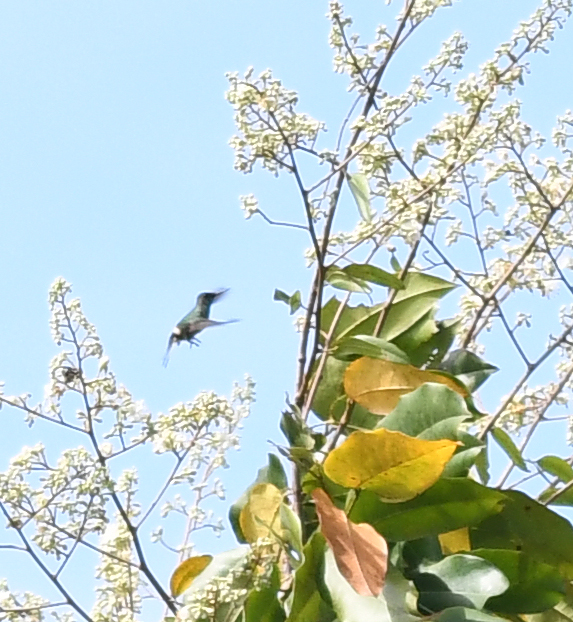 |
| Butterfly Coquette - El Paujíl, Inírida, Guainía, Colombia |
The furthest point we reached before turning around was a large black rock dome, sparsely vegetated and an interesting juxtaposition to the surrounding green forests.
 |
| El Paujíl, Inírida, Guainía, Colombia |
The sun beat down on us as we slowly made our way back, but there were still insects, reptiles and birds to be seen. We enjoyed amazing views of two elegant Paradise Jacamars.
 |
| Paradise Jacamar - El Paujíl, Inírida, Guainía, Colombia |
 |
| Paradise Jacamars - El Paujíl, Inírida, Guainía, Colombia |
We reentered the forest for a final time for the last kilometre or so of trail. The morning's excitement was far from over as we came across a pair of Ringed Woodpeckers, another new species for us. Woodpeckers are some of my favourite birds and the Neotropics are home to no shortage of beautiful species, the Ringed Woodpecker included. These individuals remained high in the trees so a few poor "record shots" were all I could manage.
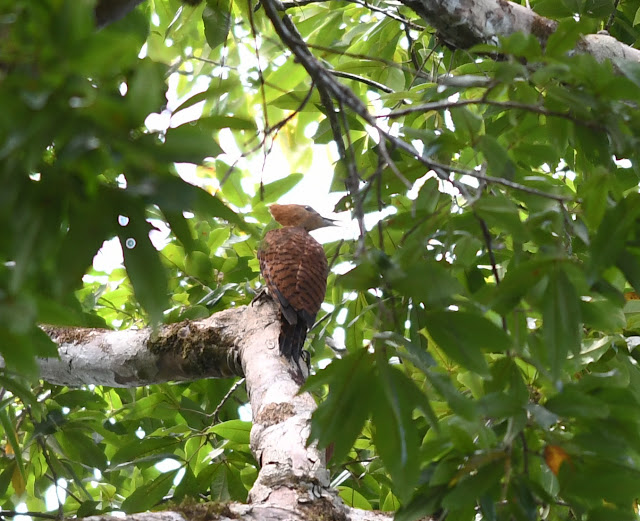 |
| Ringed Woodpecker - El Paujíl, Inírida, Guainía, Colombia |
We had nearly completed our hike when the excited call notes of various species could be heard just off the path. We investigated and our suspicions were correct - a mixed flock was working the mid-story of the forest.
Mixed-flock birding is, at the same time, both exhilarating and frustrating. After walking through a largely silent forest, there is nothing quite like the excitement that comes with picking through a busy, roving flock containing twenty or more species. But at the same time, only a fraction of these ever get identified and so you wonder about all the tantalizing birds you are missing, just out of reach somewhere in the flock.
This particular flock was a really good one, containing gems like Orinoco Softtail, Spot-winged and Blackish-grey Antshrikes, Red-stained Woodpecker and our first Rufous-tailed Xenops.
 |
| Spot-winged Antshrike - El Paujíl, Inírida, Guainía, Colombia |
Our visit to El Paujíl was fantastic and we identified nearly 100 species of birds. Despite starting out slowly, the morning concluded as one of my favourites in the Inírida area.
Laura and I had a much needed siesta at the hotel before heading out by boat for the afternoon. Our destination this time was a site called La Rompida, located an hour away to the east, along the east bank of the Río Guaviare.
In 2016 an interesting antshrike was found at La Rompida which looked very similar to the Chestnut-backed Antshrike found further south in Amazonia and southeastern Brazil. The only problem was that the Chestnut-backed Antshrike is not know from within 1000 km of this site! It was assumed that this was a new species for science, though recent genetic work has confirmed that it is an isolated population of the Chestnut-backed Antshrike. Laura and I were keen to see this population and so we headed out by boat with Mario and Yimer.
The sandbars along the Río Guaviare held many birds including flocks of herons and egrets, hundreds of Large-billed Terns (with a few Yellow-billed Terns and Black Skimmers mixed in), Pied Lapwings, Bare-faced Ibises and more. Though some of us were birding a bit harder than the others...
 |
| Río Guaviare, Vichada, Colombia |
We reached La Rompida and almost immediately found a few Chestnut-backed Antshrikes. That was easy! Their vocalizations rang out from numerous cecropia trees despite the mid-afternoon heat.
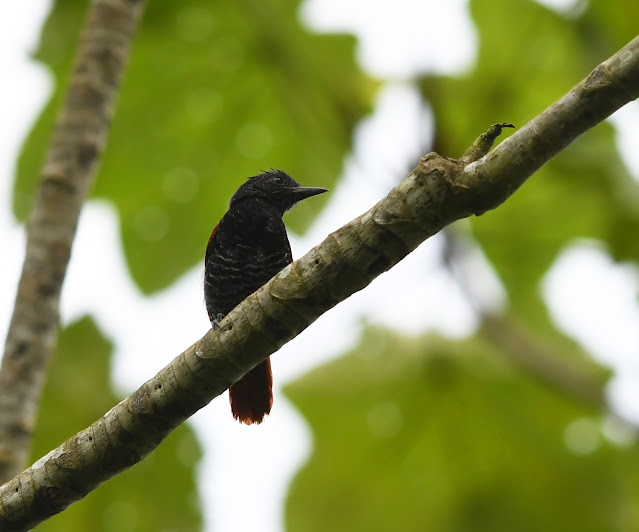 |
| Chestnut-backed Antshrike - La Rompida, Vichada, Colombia |
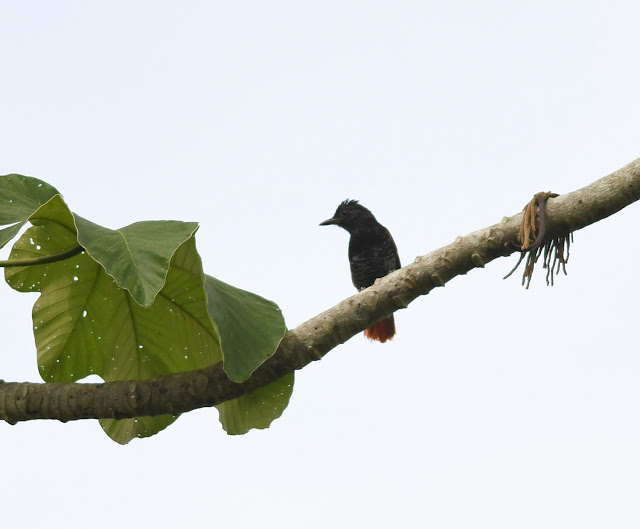 |
| Chestnut-backed Antshrike - La Rompida, Vichada, Colombia |
We enjoyed birding this area and quickly found three species of spinetails as well as some attractive White-eared Jacamars.
 |
| White-eared Jacamar - La Rompida, Vichada, Colombia |
In addition to the antshrike, the other bird species I had hoped to find at La Rompida was the Hooded Tanager, a fairly widespread species in the lowlands of South America that I had never caught up with before. It did not take us too long until we found a pair of them working over the fruit of the cecropias.
 |
| Hooded Tanager - La Rompida, Vichada, Colombia |
The grassy riverbanks here provide habitat for seedeaters and seed-finches. Several migratory species occur at La Rompida during parts of the year, including two that I had never seen before: Lined and Lesson's Seedeaters. Though we struck out on the target seedeaters, we found Gray, Yellow-bellied and Chestnut-bellied Seedeaters.
 |
| Chestnut-bellied Seedeaters - La Rompida, Vichada, Colombia |
A Rufous-breasted Hermit provided amazing views as it perched down low. Typically I see hermits blasting past, or perhaps pausing briefly at a heliconia flower. A chance to study one at rest is a relatively rare occurrence for me.
 |
| Rufous-breasted Hermit - La Rompida, Vichada, Colombia |
I had hoped to stay at La Rompida until dusk so that we could enjoy the Sand-colored Nighthawk show that occurs each evening. Unfortunately, Yimer indicated that we needed to leave before it got too dark because the visibility in the water was not great and there were many lurking downed trees. After the shenanigans two days earlier at Cerros de Mavecure, I could not blame him for exercising an abundance of caution.
And though Sand-colored Nighthawk remained one of my few misses during our Inírida visit, our early departure from La Rompida allowed us to enjoy the wading-bird, shorebird and tern spectacle on the journey back.
 |
| Large-billed Terns - Río Guaviare, Vichada, Colombia |
 |
| Black Skimmers - Río Guaviare, Vichada, Colombia |
 |
| Pied Lapwing - Río Guaviare, Vichada, Colombia |
A Jabiru slowly cruised overhead, representing the final year bird of the day. Another great day....
 |
| Jabiru - Río Guaviare, Vichada, Colombia |




































